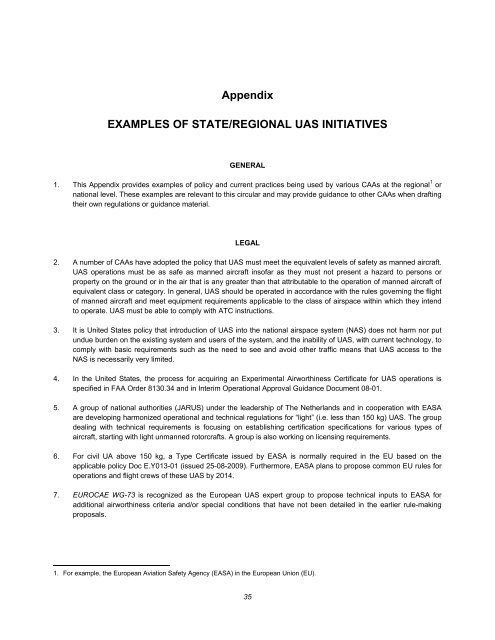1AswVkP
1AswVkP
1AswVkP
Create successful ePaper yourself
Turn your PDF publications into a flip-book with our unique Google optimized e-Paper software.
Appendix<br />
EXAMPLES OF STATE/REGIONAL UAS INITIATIVES<br />
GENERAL<br />
1. This Appendix provides examples of policy and current practices being used by various CAAs at the regional 1 or<br />
national level. These examples are relevant to this circular and may provide guidance to other CAAs when drafting<br />
their own regulations or guidance material.<br />
LEGAL<br />
2. A number of CAAs have adopted the policy that UAS must meet the equivalent levels of safety as manned aircraft.<br />
UAS operations must be as safe as manned aircraft insofar as they must not present a hazard to persons or<br />
property on the ground or in the air that is any greater than that attributable to the operation of manned aircraft of<br />
equivalent class or category. In general, UAS should be operated in accordance with the rules governing the flight<br />
of manned aircraft and meet equipment requirements applicable to the class of airspace within which they intend<br />
to operate. UAS must be able to comply with ATC instructions.<br />
3. It is United States policy that introduction of UAS into the national airspace system (NAS) does not harm nor put<br />
undue burden on the existing system and users of the system, and the inability of UAS, with current technology, to<br />
comply with basic requirements such as the need to see and avoid other traffic means that UAS access to the<br />
NAS is necessarily very limited.<br />
4. In the United States, the process for acquiring an Experimental Airworthiness Certificate for UAS operations is<br />
specified in FAA Order 8130.34 and in Interim Operational Approval Guidance Document 08-01.<br />
5. A group of national authorities (JARUS) under the leadership of The Netherlands and in cooperation with EASA<br />
are developing harmonized operational and technical regulations for “light” (i.e. less than 150 kg) UAS. The group<br />
dealing with technical requirements is focusing on establishing certification specifications for various types of<br />
aircraft, starting with light unmanned rotorcrafts. A group is also working on licensing requirements.<br />
6. For civil UA above 150 kg, a Type Certificate issued by EASA is normally required in the EU based on the<br />
applicable policy Doc E.Y013-01 (issued 25-08-2009). Furthermore, EASA plans to propose common EU rules for<br />
operations and flight crews of these UAS by 2014.<br />
7. EUROCAE WG-73 is recognized as the European UAS expert group to propose technical inputs to EASA for<br />
additional airworthiness criteria and/or special conditions that have not been detailed in the earlier rule-making<br />
proposals.<br />
1. For example, the European Aviation Safety Agency (EASA) in the European Union (EU).<br />
35


